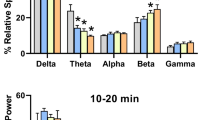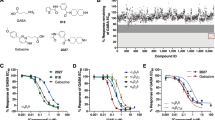Abstract
Background
Anxiolytic benzodiazepines, due to their clinical effectiveness, are one of the most prescribed drugs worldwide, despite being associated with sedative effects and impaired psychomotor and cognitive performance. Not every GABAA receptor functions in the same manner. Those containing α1 subunits are associated with sleep regulation and have a greater effect on the sedative-hypnotic benzodiazepines, whereas those containing α2 and/or α3 subunits are associated with anxiety phenomena and have a greater effect on the anxiolytic benzodiazepines. Therefore, characterization of the selectivity profile of anxiolytic drugs could translate into a significant clinical impact.
Methods
The present study pharmacodynamically evaluated chlornordiazepam, the main active metabolite of mexazolam, upon GABAA receptors containing α2 and/or α3, anxiety-related, and those containing an α1 subunit, associated with sleep modulation.
Results
As shown by whole-cell patch-clamp data, chlornordiazepam potentiated GABA-evoked current amplitude in α2 and α3 containing receptors without changing the current amplitude in α1 containing receptors. However, current decay time increased, particularly in GABAA receptors containing α1 subunits. In contrast, other anxiolytic benzodiazepines such as alprazolam, bromazepam, and zolpidem, all increased currents associated with GABAA receptors containing the α1 subunit.
Conclusions
This novel evidence demonstrates that mexazolam (through its main metabolite chlornordiazepam) has a “pharmacodynamic fingerprint” that correlates better with an anxiolytic profile and fewer sedative effects, when compared to alprazolam, bromazepam and zolpidem, explaining clinical trial outcomes with these drugs. This also highlights the relevance of the pharmacological selectivity over GABAA receptor subtypes in the selection of benzodiazepines, in addition to their clinical performance and pharmacokinetic characteristics.



Similar content being viewed by others
Data availability
The datasets generated and/or analysed during the current study are available from the corresponding author on reasonable request.
Abbreviations
- ALZ:
-
Alprazolam
- BRO:
-
Bromazepam
- CND:
-
Chlornordiazepam
- GABAA :
-
Gamma-aminobutyric acid A
- MEX:
-
Mexazolam
- ZLP:
-
Zolpidem
References
Olsen R, Sieghart W. International union of pharmacology. LXX. Subtypes of γ-aminobutyric AcidA receptores: classification on the basis of subunit composition, pharmacology, and function. Update. Pharmacol Rev. 2008;60(3):243–59.
Stahl SM. Anxiety disorders and anxiolytics (chapter 9). In: Stahl’s essential psychopharmacology: neuroscientific basis and practical applications. forth. New York: Cambridge University Press; 2013. p. 388–419.
Graham D, Faure G, Besnard F, Langer SZ. Pharmacological profile of benzodiazepine site ligands wit recombinant GABAA receptor subtypes. Eur Neuropsychopharmacol. 1996;6(2):119–25.
Harrison NL. Mechanisms of sleep induction by GABA(A) receptor agonists. J Clin Psychiatry. 2007;68(Suppl5):6–12.
Cheng T, Wallace DM, Ponteri B, Tuli M. Valium without dependence? Individual GABAA receptor subtype contribution toward benzodiazepine addiction, tolerance, and therapeutic effects. Neuropsychiatry Dis Treat. 2018;14:1351–61.
Tan KR, Rudolph U, Lüscher C. Hooked on benzodiazepines: GABAA receptor subtypes and addiction. Trends Neurosci. 2011;34(4):188–97.
Ali AB, Thomson AM. Synaptic a5 subunit-containing GABAA receptors mediate IPSPs elicited by dendrite-preferring cells in rat neocortex. Cereb Cortex. 2008;18:1260–71.
Magnin E, Francavilla R, Amalyan S, Gervais E, David LS, Luo X, et al. Input-specific synaptic location and function of the α5 GABAA receptor subunit in the mouse CA1 hippocampal neurons. J neurosci. 2019;39(5):788–801.
Rudolph U, Möhler H. GABAA Receptor Subtypes. Therapeutic potential in down syndrome, affective disorders, schizophrenia, and autism. Annu Rev Pharmacol Toxicol. 2014;54:483–507.
Whiting PJ. GABAA Receptor subtypes in the brain: a paradigm for CNS drug discovery? Drug Discov Today. 2003;8(10):445–50.
Atack JR. GABAA receptor subtype-selective modulators. I. α2/α3-selective agonists as non-sedating anxiolytics. Curr top Med Chem. 2011;11:1176–202.
Chen X, Gerven JV, Cohen A, Jacobs G. Human pharmacology of positive GABAA subtype-selective receptor modulators for the treatment of anxiety. Acta Pharmacol Sin. 2019;40:571–82.
Rudolph U, Knoflach F. Beyond classical benzodiazepines: novel therapeutic potential of GABAA receptor subtypes. Nat Rev Drug Discov. 2012;10(9):685–97.
Skolnick P. Anxioselective anxiolytics: on a quest for the Holy Grail. Trends Pharmacol Sci. 2012;33:611–20.
Cerne R, Lippa A, Poe M, Smith J, Jin X, Ping X, et al. GABAkines - advances in the discovery, development, and commercialization of positive allosteric modulators of GABAA receptors. Pharmacol Ther. 2022;234:108035.
Fernandes H, Moreira R. Mexazolam: clinical efficacy and tolerability. Neurol Ther. 2014;3(1):1–14.
Coelho MAV, Garrett J. Mexazolam in anxiety disorders: results of a multicenter trial. Adv Ther. 1997;14(3):125–33.
Ferreira L, Figueira ML, Bessa-Peixoto A, Marieiro A, Albuquerque R, Paz C, et al. Psychomotor and anxiolytic effects of mexazolam in patients with generalised anxiety disorder. Clin Drug Invest. 2003;23(4):235–43.
Silveira P, Vaz-da-Silva M, Dolgner A, Almeida L. Psychomotor effects of mexazolam vs. placebo in healthy volunteers. Clin Drug Invest. 2002;22(10):677–84.
Bourin M, Auget JL, Colombel MC, Larousse C. Effects of single oral doses of bromazepam, buspirone and clobazam on performance tasks and memory. Neuropsychobiology. 1989;22(3):141–5.
Leufkens TR, Vermeeren A, Smink BE, van Ruitenbeek P, Ramaekers JG. Cognitive, psychomotor and actual driving performance in healthy volunteers after immediate and extended release formulations of alprazolam 1 mg. Psychopharmacology. 2007;191(4):951–9.
Schaffler K, Klausnitzer W. Placebo-controlled study on acute and subchronic effects of buspirone vs bromazepam utilizing psychomotor and cognitive assessments in healthy volunteers. Pharmacopsychiatry. 1989;22(1):26–33.
Verster JC, Volkerts ER, Verbaten MN. Effects of alprazolam on driving ability, memory functioning and psychomotor performance: a randomized, placebo-controlled study. Neuropsychopharmacology. 2002;27(2):260–9.
Ropert R, Bernes J, Dachary JM. Efficacy and tolerance of alprazolam and bromazepam in flexible doses. Double-blind study in 119 ambulatory anxious patients. Encephale. 1987;13(2):89–95.
Sonne LM, Bruun-Hansen J. Alprazolam (Tafil) and bromazepam (Lexotan) in the treatment of anxiety. A randomized, double-blind comparison in psychiatric outpatients. Ugeskr Laeger. 1986;148(23):1392–5.
Vaz Serra A, Firmino H. Estudo clínico com dupla ocultação comparando mexazolam com bromazepam. Psiquiatr Clín. 1993;14(2):77–84.
Vaz Serra A, Figueira ML, Bessa-Peixoto A, Firmino H, Albuquerque R, Paz C, et al. Mexazolam and alprazolam in the treatment of generalised anxiety disorders, a double-blind, randomised clinical trial. Clin Drug Invest. 2001;21(4):257–63.
Miyakoshi N, Shindo H. Whole-body Autoradiography of RAZ-386-14C after Oral Administration to Mice. RCR. 1971;115–042.
Allen JG, Galloway DB, Ehsanullah RS, Ruane RJ, Bird HA. The effect of bromazepam (Lexotan) administration on antipyrine pharmacokinetics in humans. Xenobiotica. 1984;14(4):321–6.
Ait-Daoud N, Hamby AS, Sharma S, Blevins D. A review of alprazolam use, misuse, and withdrawal. J Addict Med. 2018;12(1):4–10.
Griffin C, Kaye AM, Kaye AD. Benzodiazepine pharmacology and central nervous system – mediated effects. Ochsner J. 2013;13(2):214–23.
Greenblatt DJ, Wright CE. Clinical pharmacokinetics of alprazolam. Therapeutic implications. Clin Pharmacokinet. 1993;24(6):453–71.
Masiulis S, Desai R, Uchanski T, Martin IS, Laverty D, Karia D, et al. GABAA Receptor signalling mechanisms revealed by structural pharmacology. Nature. 2019;565(7740):454–9.
Greenblatt DJ, Wright CE. Clinical pharmacokinetics of alprazolam. Clin Pharmacokinet. 1993;24(6):453–71.
Altamura AC, Moliterno D, Paletta S, Maffini M, Maui MC, Bareggi S. Understanding the pharmacolinetics of anxiolytic drugs. Expert Opin Drug Metab Toxicol. 2013;9(4):423–40.
Yamaguchi K et al. Determination of blood and urinary concentration after CS-386 administration in Human (Report no.1). Anal Metab Res Cent Res Lab. 1997;124–282.
Salva P, Costa J. Clinical pharmacokinetics and pharmacodynamics of zolpidem. Therapeutic implications. Clin Pharmacokinet. 1995;29(3):142–53.
Kamioka T, Nakayama I, Akiyama S, Takagi H. Effects of oxazolam, cloxazolam, and CS-386, new anti-anxiety drugs, on socially induced suppression and aggression in pairs of monkeys. Psychopharmacology. 1977;52:17–23.
Masneuf S, Buetler J, Koester C, Crestani F. Role of a1- and a2-GABAA receptors in mediating the respiratory changes associated with benzodiazepine sedation. Br J Pharmacol. 2012;166:339–48.
Sana E, Davide P, Tuveri F, Massa F, Maciocco E, Acquas C, Floris C, et al. Molecular and neurochemical evaluation of the effects of etiozolam on GABAA receptors under normal and stress conditions. Arzneim-Forsch/Drug Res. 1999;49(1):88–95.
Mattei C, Taly A, Soualah Z, Saulais O, Henrion D, Guérineau NC, et al. Involvement of the GABAA receptor α subunit in the mode of action of etifoxine. Pharmacol Res. 2019;145:1042–50.
Dias R, Sheppard W, Fradley RL, Garrett E, Stanley J, Tye S, et al. Evidence for a significant role of alpha 3-containing GABAA receptors in mediating the anxiolytic effects of benzodiazepines. J Neurosci. 2005;25(46):10682–8.
Puga F, Veiga H, Cagy M, McDowell K, Piedade R, Ribeiro P. Analysis of the influence of bromazepam on cognitive performance through the visual evoked potential (P300). Arq Neuropsiquiatr. 2005;63(2A):228–34.
Hindmarch I, Trick L, Ridout F. A Double-blind, placebo- and positive-internal-controlled (alprazolam) investigation of the cognitive and psychomotor profile of pregabalin in healthy volunteers. Psychopharmacology. 2005;183(2):133–43.
Galarreta M, Hestrin S. Properties of GABAA receptores underlying inhibitory synaptic currents in neocortical pyramidal neurons. J Neurosci. 1997;17(19):7220–7.
Jones MV, Westbrook GL. The impact of receptor desensitization on fast synaptic transmission. Trends Neurosci. 1996;19:96–101.
Overstreet LS, Jones MV, Westbrook GL. Slow Desensitization regulates the availability of synaptic GABAA receptors. J Neurosci. 2000;20(21):7914–21.
Eyre MD, Renzi M, Farrant M, Nusser Z. Setting the time course of inhibitory synaptic currents by mixing multiple GABAA receptor α subunit isoforms. J Neurosci. 2012;32(17):5853–67.
Nusser Z, Cull-Candy S, Farrant M. Differences in synaptic GABAA receptor number underlie variation in GABA mini amplitude. Neuron. 1997;19:697–709.
Funding
These electrophysiological experiments were conducted by B’SYS and supported by BIAL.
Author information
Authors and Affiliations
Contributions
HF, VB, MJB, MAV and PSS: conceptually designed the study, wrote the protocol and the first draft of the manuscript. SH and EB: conducted the laboratory experiments and wrote the study report. All authors contributed to and have approved the final manuscript.
Corresponding author
Ethics declarations
Conflict of interest
Hélder Fernandes, Vânia Batalha, Maria João Bonifácio and Patrício Soares-da-Silva were employees of BIAL—Portela & Cª S.A at the time of the study. Simon Hebeisen and Ellen Braksator were employees of B'SYS GmbH at the time of the study. B'SYS GmbH received a grant from BIAL—Portela & Cª, S.A.
Additional information
Publisher's Note
Springer Nature remains neutral with regard to jurisdictional claims in published maps and institutional affiliations.
Supplementary Information
Below is the link to the electronic supplementary material.
Rights and permissions
Springer Nature or its licensor holds exclusive rights to this article under a publishing agreement with the author(s) or other rightsholder(s); author self-archiving of the accepted manuscript version of this article is solely governed by the terms of such publishing agreement and applicable law.
About this article
Cite this article
Fernandes, H., Batalha, V., Braksator, E. et al. Voltage-clamp evidence of GABAA receptor subunit-specific effects: pharmacodynamic fingerprint of chlornordiazepam, the major active metabolite of mexazolam, as compared to alprazolam, bromazepam, and zolpidem. Pharmacol. Rep 74, 956–968 (2022). https://doi.org/10.1007/s43440-022-00411-x
Received:
Revised:
Accepted:
Published:
Issue Date:
DOI: https://doi.org/10.1007/s43440-022-00411-x




